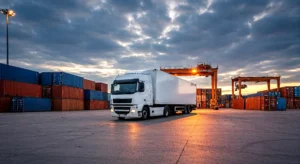The United States is in a better position to address the challenges arising from the situation in the Red Sea, according to experts.
The freight sector in the United States is in better condition, according to experts, to address the challenges arising from the situation in the Red Sea, thanks to efforts to improve capacity amid the slowdown in freight transportation.
Current data from Project44 indicates that most vessels are experiencing an increase in transit time ranging from seven to 20 days. This situation has significantly impacted the efficiency and speed of maritime transportation worldwide, affecting the rest of the transportation sector.
Uber Freight Market Update and Outlook Report for the first quarter of 2024, shows maritime freight transportation is experiencing a 40% slowdown, equivalent to nearly two weeks of delays in supply chains. As a result, most carriers have chosen not to renew operations in the region until the risk of attacks disappears.

According to Transport Topics, Mollie LeBlanc, Uber Freight’s ocean expert, has observed some downward effects on U.S. transportation, such as the increase in volumes diverted through ports on the west coast. LeBlanc stated that the current excess capacity has allowed commerce to adapt to a truly adverse situation.
Project44 data also reveals that rates from Asia to the U.S. East Coast have increased by almost 175% since October. And rates at the West Coast increased by 97%. The report also warns of a possible increase in fuel costs, as some maritime carriers have imposed surcharges ranging from $500 to $2,700.
What’s ahead for the freight industry in the U.S.?
Eric Fullerton, Project44’s Director of Product Marketing, mentioned that the impact on U.S. transportation is twofold, as it not only concerns transit times but also cost increases. While routes from Asia to Europe have seen the most significant increases, Fullerton stated that rates for routes to the U.S. have also risen.
Transport Topics reports that Pawan Joshi, Executive Vice President of Products and Strategy at E2open, noted that increased transit times also entail higher costs for crews and fuel. Additionally, he indicated that the situation is mixed in terms of downward effects, given the current freight market.
Joshi added that these shipments include not only finished products but also raw materials, which could cause production delays. However, he believes that the supply chain is better positioned to manage these disruptions due to the slowdown in macroeconomic conditions, which has led to reduced demand.

Trucking faces continued job losses as 2026 uncertainty looms
The U.S. trucking industry continues to lose jobs and reduce capacity, will this trend continue in 2026? The U.S. trucking industry continues to lose jobs

U.S. Allocates $1.5 Billion for Truck Road Infrastructure
The 2026 BUILD Grants program will invest $1.5 billion in truck road infrastructure across highways, ports, and truck parking facilities, with direct impact on logistics and freight transportation in the United States.

Wall Street Record: Transportation Stocks Boost Confidence in the Economy and Logistics
Transportation stocks in the United States have staged a strong rally so far in 2025, reflecting growing market confidence in the real economic activity behind logistics, freight movement, and mobility services more broadly.

The meaning of Hanukkah and how to celebrate it on the road
Hanukkah is a celebration of resilience and hope, and here are some ways you can take this on the road. December is one of the

Waymo under investigation for potential safety risk in school zones
A recent wave of videos has shown that some Waymo vehicles are not complying with safety regulations in school zones. The autonomous vehicle company Waymo,

Don’t Blame the Snow: The Real Causes Behind Winter Truck Accidents
Don’t Blame the Snow: Why Most Winter Truck Accidents Are Preventable
